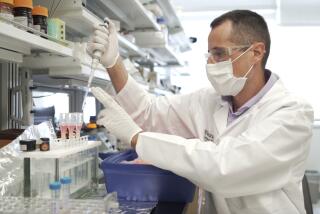Test May Offer Quick Alzheimer’s Diagnosis
- Share via
Pasadena researchers say they have identified a previously unsuspected chemical imbalance in the brains of patients with Alzheimer’s disease and have developed a sophisticated test that permits quick diagnosis of the disorder.
Early diagnosis of Alzheimer’s, which affects up to 4 million Americans, is becoming increasingly important as researchers develop drugs that they hope can impede the progress of the disease. Most researchers believe that these drugs will be most valuable when used in the early stages of Alzheimer’s, but early detection is extremely difficult.
Dr. Brian D. Ross, a neurologist at the Huntington Medical Research Institutes, and his colleagues have modified a magnetic resonance scanner to look for chemical differences between the brains of Alzheimer’s patients and healthy individuals.
They report today in the journal Radiology that they found an increase in the concentration of the sugar myo-inositol in the brains of patients with Alzheimer’s and a decrease in another chemical, called N-acetylaspartate or NAA. This combination of changes seems to be unique to Alzheimer’s disease and could provide the basis for a technique for quick diagnosis.
Alzheimer’s disease is diagnosed by the exclusion of all other possible brain disorders, as well as by a battery of mental function and neurophysiological tests--a process that is time-consuming and expensive. A definitive diagnosis can often be made only after death, when an autopsy reveals the extensive plaques and tangles in the brain that are characteristic of the disease.
Researchers do not yet know whether the changes are related to the biology of Alzheimer’s or whether they are a secondary effect, Ross said. But if it is the former, then the discovery could lead to new forms of therapy for the disease.
“This obviously has to be replicated, but it is very promising,” said Dr. Michael Weiner, director of the magnetic resonance unit at the San Francisco Veterans Affairs Hospital. “We’re excited about the possibility that this might be used in clinical evaluation of Alzheimer’s disease, but at this time we must emphasize that it is still a research tool.”
Dr. Richard J. Wurtman, director of the Clinical Research Center at the Massachusetts Institute of Technology and an expert in the biochemistry of Alzheimer’s, said: “If it’s confirmed, it could be quite interesting.”
Alzheimer’s disease primarily strikes people over the age of 65 and is characterized by memory loss, disorientation, depression and deterioration of bodily functions. It is ultimately fatal, causing about 100,000 deaths in the United States every year.
Several researchers have recently reported that they can use magnetic resonance imaging, which produces pictures of the brain, and another technique called PET scanning to diagnose Alzheimer’s by detecting areas of cell death associated with it, but these techniques are not in clinical use.
Furthermore, Weiner said, because the changes in brain structure monitored by these techniques are subtle, MRI and PET are much less sensitive for diagnosing Alzheimer’s than magnetic resonance scanning, which detects the levels of individual chemicals within the brain.
Weiner has used MR scanning to study Alzheimer’s patients’ brains and has found an increased level of a crucial chemical called choline in the brains of patients with advanced disease as well as a decrease in NAA. Wurtman has also found high levels of choline in autopsy samples. Already, he added, it is clear that low levels of NAA “are going to be a more sensitive detector of neuron loss (in Alzheimer’s) than more conventional measures.”
The biggest problem with Ross’ study, he acknowledges, is that the study group is small--11 patients who were already known to have Alzheimer’s and 10 healthy individuals. Ross is gearing up to study more patients and to determine if the technique is successful for even earlier diagnosis of Alzheimer’s in patients where the disease is only suspected. He is also making plans to study the biochemistry of Alzheimer’s to determine the actual role of myo-inositol in the disease.
If the technique proves successful it could be widely adopted very quickly, Ross said. Although conventional MR imagers are not normally equipped for MR scanning, they can be adapted to carry it out for about $10,000--a “trivial amount,” he said, compared to the $2-million cost of the machine.






